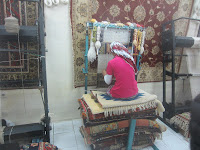While we were visiting Tangier we came into contact with a rug merchant. We like the beauty of the hand knotted Oriental rugs. However, we did not like the agressive sales technique used. We were awe-struck by the beauty of the rugs. We escaped the clutches of the salesman with me complaining that he did not have one which was a flying carpet, and therefore we would not buy.
Oriental rugs are rugs made in the "Orient" which refers to Asia. Little did I know that we would have the opportunity to purchase a rug at the point origin again.
In 2012 we were fortunate to go on a short tour of Turkey. There we were able to observe the manufacture of the beautiful rugs in person. The manufacturing facility we visited was a school supported by the Turkish government. Reminiscent of Mahatma Ghandi's cottage industries, the Turkish government supports schools where carpet or rug weaving is taught. It is a gender specific endeavor. Only women are carpet weavers. However, those who repair carpets are male. Interesting? The women are taught this skill so they can work in carpet factories or can work at their own looms in their homes. We entered this school and were introduced to the process by the school administrator. He showed us the threads and yarns used in the manufacturing of double knotted carpets. The substrate or that which provides structure can be of one material while the pile can be of another. For example, the most common combination is cotton and wool. the Cotton provides the structure while the wool provides the pile. Other combinations are cotton-silk, wool-wool, and silk-silk. The most striking and beautiful carpets are made of the of the cotton-silk and silk-silk combinations. Each of these combinations were shown to us to observe and feel. How a textile fabric feels is called its "hand" and the silk carpets had the best hand. Another attribute of the silk carpets was the ability to appear to change color. This visual delight occurs because the silk fiber is triangular rather than circular in cross-section and therefore reflects light differently. Carpets have been made by the double-knot method probably as early as the fourth century B.C., but one of the greatest innovations was in the twentieth century. When Kaiser Wilhelm visited Turkey drumming up support for his upcoming war, WWI, he introduced the Turkish carpet makers to chemical dyes. Until then carpet yarns had been dyed with vegetable dyes but chemical dyes gave them a greater range of color and colors that were more brilliant. One of the most beautiful rugs exhibited depicted Da Vinci's
Last Supper, silk on silk. This was obviously created for tourists. Turkey is a Moslem nation, and the religion does not allow images of people. Our introduction to rug making ran the gamut from yarn manufacture to rug production. As a person who had spent a bit of his working life in the textile industry it was most interesting to me. In one part of the training area we saw a woman in native dress, kerchiefed head and baggy pants, standing beside a wooden barrel with white threads being drawn from it. By the smile on her wrinkled face I could tell that she did not understand a word we were saying. As we looked inside the barrel to see silk cocoons, about one and one quarter inches, floating in the water, Claudette asked our guide, "How much thread is on each cocoon?"
The fairly young man in a sport coat said in slightly accented English, "It is only one thread. It is wound around the caterpillar. It can be over 1200 meters long." I made a quick calculation with my cell phone. That would be a thread over thirteen football fields long!
"Why are they in water?" she asked.
"We must put them in hot water to kill the caterpillar. It makes the thread easier to unwind."
We watched as the woman with a gnarled hand guided about a dozen threads from the cocoons over a drum onto a large spool for winding. The spool was driven by a foot pedal. Very little foot pressure was needed, but a constant speed was required. We found out that the silk cocoons came from the operator's family. This silk thread would be used to make rugs.
Next, we watched the weavers make the rugs. Actually, they may be referred to as knotters. The rug is basically a simply woven substrate with knots of yarn attacked to the warp (longitudinal) threads. The tail of the knots are trimmed to produce the pile of the rug.
We entered a large room with seats around the edge of a beautiful hardwood floor. It was time for the rug show. The rug "wranglers" brought out rug after rug of various sizes, design, and construction. They are exquisite. We were offered beverages while the rugs were shown. Tea was available, dark and sweet. It is served in small clear glasses, cylindrical and about 1.5 inches n diameter. The other choice of beverage is indeed an adult one.
Raki, the official alcoholic beverage of Turkey, is served in the same size glass It is a brandy made of the leftovers of wine making. It is very strong and is served with water. Real men don't drink diluted
raki! It was a humbling experience to assert my manhood. I am sure that the imbibing of the beverage increases the probability of a purchase and will allow one to fly without the requisite carpet.
We were shown a multitude of carpets, but one in particular caught our eyes. It was a thing of beauty, made of natural woolen yarns (no dye used). We were told that the time to manufacture it was about two months. This was very believable considering the tedious process we had observed in the factory. Needless to say, we bought a carpet.




No comments:
Post a Comment
What do you think of this post?